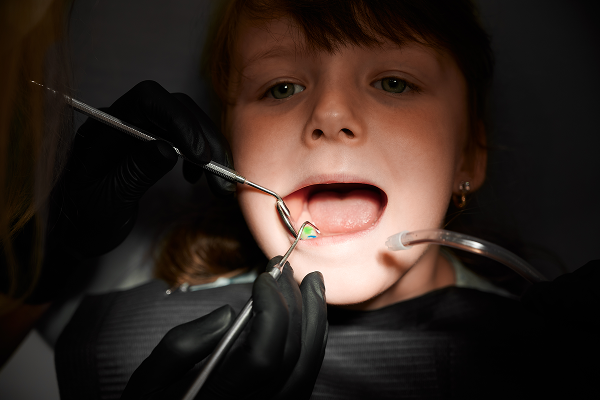Many adults still remember childhood dental visits as something unpleasant — pain, fear, and uncomfortable sensations. Back then, going to the dentist often meant bracing for a traumatic experience. But today, things are very different: modern pediatric dentistry focuses on comfort, gentle care, and pain-free treatment.
Dentists now take into account a child’s psychology, using minimally invasive techniques and child-friendly materials, creating a calm, trusting — and sometimes even playful — environment. Getting a filling in a baby tooth doesn’t have to be scary — in fact, it can even be fun and engaging.
Dentists now take into account a child’s psychology, using minimally invasive techniques and child-friendly materials, creating a calm, trusting — and sometimes even playful — environment. Getting a filling in a baby tooth doesn’t have to be scary — in fact, it can even be fun and engaging.
Why Treat Baby Teeth If They’ll Fall Out Anyway?
This is still one of the most common questions parents ask. Many believe, “We didn’t get dental treatment as kids and we turned out fine.” But modern dentistry has long since shown that baby teeth play a crucial role in the development of speech, bite alignment, and the health of future permanent teeth.
Research shows that untreated cavities in baby teeth can lead to:
• inflammation of the surrounding gum tissue,
• damage to the underlying permanent tooth buds,
• misaligned bite or jaw development,
• chronic infections.
In addition, tooth pain or discomfort can affect a child’s sleep, mood, and overall well-being. So getting a temporary filling isn’t a short-term fix — it’s an investment in their long-term health.
Research shows that untreated cavities in baby teeth can lead to:
• inflammation of the surrounding gum tissue,
• damage to the underlying permanent tooth buds,
• misaligned bite or jaw development,
• chronic infections.
In addition, tooth pain or discomfort can affect a child’s sleep, mood, and overall well-being. So getting a temporary filling isn’t a short-term fix — it’s an investment in their long-term health.

A Filling for a Child? It’s Not a Big Deal
Modern dental fillings for children are quick, gentle, and adapted to the needs of young patients. Pediatric dentists use:
• minimally invasive cavity removal techniques (like air abrasion instead of drilling, suitable for early-stage decay),
• topical numbing gels or sprays, no needles required,
• distraction tools like cartoons, play areas, or “magic glasses.”
All of this helps a child see the dentist as a friend, not a threat. The process is tailored to be as emotionally and physically comfortable as possible — no fear, no trauma.
• minimally invasive cavity removal techniques (like air abrasion instead of drilling, suitable for early-stage decay),
• topical numbing gels or sprays, no needles required,
• distraction tools like cartoons, play areas, or “magic glasses.”
All of this helps a child see the dentist as a friend, not a threat. The process is tailored to be as emotionally and physically comfortable as possible — no fear, no trauma.
What Types of Fillings Do Kids Get?
There are two main types of pediatric dental fillings:
• Temporary fillings – used when the baby tooth is close to falling out or when a short-term solution is needed.
• Long-lasting fillings – made from durable modern materials that can withstand chewing and last until the tooth naturally falls out.
• Temporary fillings – used when the baby tooth is close to falling out or when a short-term solution is needed.
• Long-lasting fillings – made from durable modern materials that can withstand chewing and last until the tooth naturally falls out.
Colorful fillings deserve a special mention. Not only do they restore the tooth, but they also give the child a sense of control and fun — choosing a color, turning the treatment into a game, even showing off their “magic tooth” to friends.
(Note: colorful fillings may not be suitable for teeth that bear heavy chewing pressure. Your dentist will advise accordingly.)
(Note: colorful fillings may not be suitable for teeth that bear heavy chewing pressure. Your dentist will advise accordingly.)

What About Silver Diamine Fluoride (SDF)?
Tooth “silvering” — or the application of silver diamine fluoride (SDF) — is a preventive treatment that slows down decay by coating the tooth with an antibacterial silver nitrate solution. However, it stains the tooth black and is only effective in early stages of decay.
It’s important to understand that SDF is not a substitute for full treatment if the tooth structure is already significantly damaged.
It’s important to understand that SDF is not a substitute for full treatment if the tooth structure is already significantly damaged.
Pediatric Dentistry Today Is on a Whole New Level
It’s no longer about fear — it’s about care, comfort, and child-centered treatment. Modern fillings for baby teeth are not just painless — in many cases, they’re exciting and even fun for kids.
If you’re hesitant to schedule that visit because of past fears or discomfort, rest assured: dentistry today is designed with children in mind — and it shows.
If you’re hesitant to schedule that visit because of past fears or discomfort, rest assured: dentistry today is designed with children in mind — and it shows.
Book a Consultation Today!
📞 Call: +971 55 401 1505 or message us on Telegram/WhatsApp. Find out the exact cost of your treatment and how quickly it can be completed.



